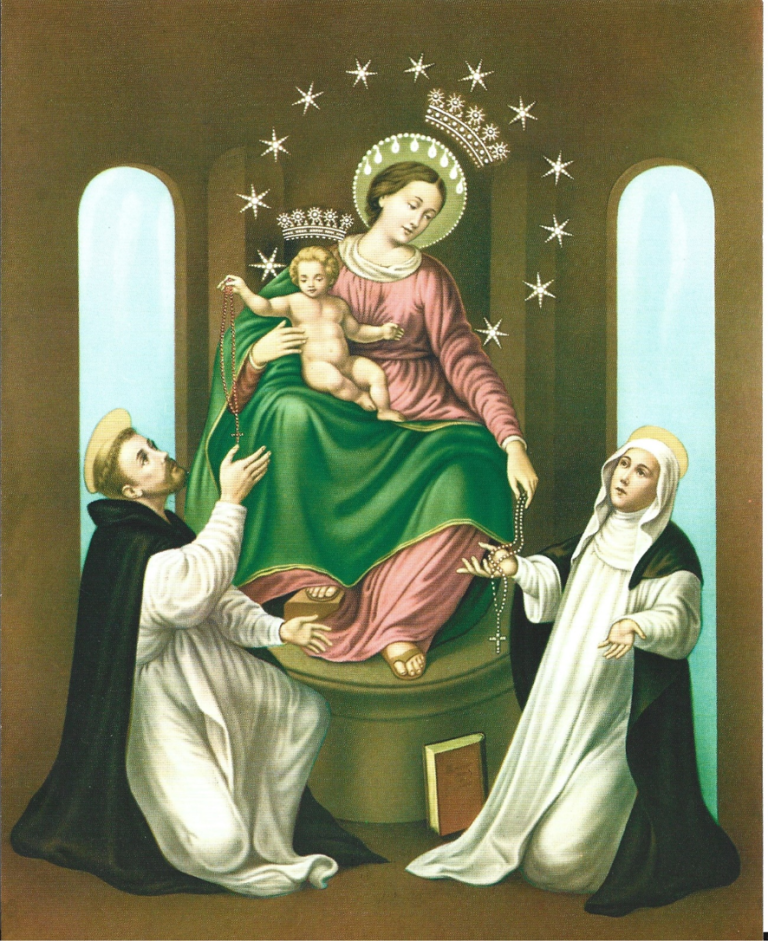

Nossa Senhora do Rosário
Oração
“Na terra recordamos Teu gozo e Tua dor, ó Mãe, que contemplamos em glória e resplendor.
Ave, quando concebes, visitas, dás à luz, e levas e recebes no templo o Teu Jesus.
Ave, pela agonia, flagelo, espinho e cruz: a dor da profecia à glória Te conduz.
Ave, sobre o Teu Filho, o espírito nos vem; deixando o nosso exílio, ao céu sobes também.
Cento e cinquenta rosas, nações, vinde colher: coroas luminosas à Virgem Mãe tecer.
Louvor ao Pai e ao Filho, e ao Espírito também; dos três, divino auxílio ao nosso encontro vem.”
História
Conta uma lenda que foi a própria Maria, ao aparecer para São Domingos, que ensinou a recitação do Rosário, como arma eficaz para debelar os hereges albigenses. Todavia, o terço, objeto da recitação do Rosário, é de origem bastante antiga.
Os orientais já usavam pedrinhas para contar o número de orações vocais. Nos conventos medievais ocidentais, os leigos completavam as suas práticas de piedade com a recitação de diversos Pai-Nossos, e São Beda lhes sugeriu que usassem vários grãos enfiados num barbante para a contagem das recitações.
O Rosário propriamente dito nasceu durante as cruzadas na Terra Santa, como fruto do amor dos cristãos por Maria, e foi difundido pelos padres dominicanos, também criadores das confrarias do Rosário.
O Rosário encerra o significado de uma grinalda de rosas oferecida à Nossa Senhora. A recomendação oficial da recitação do Rosário foi instituída pelo Papa Pio V, que também instituiu a festa do Rosário em 1571, para comemorar a vitória contra os turcos em Lepanto.
Até hoje, por instituição do Papa Pio X, a festa do Santíssimo Rosário e, por extensão, de Nossa Senhora do Rosário, é realizada no mesmo dia 7 de outubro.
Our Lady of Rosario
Prayer
“On earth we remember Your joy and Your pain, O Mother, which we contemplate in glory and resplendence.
Hail, when you conceive, you visit, you give birth, and you take and receive your Jesus in the temple.
Hail, through agony, scourge, thorn and cross: the pain of prophecy leads you to glory.
Hail, upon Your Son, the spirit comes to us; Leaving our exile, you also ascend to heaven.
One hundred and fifty roses, nations, come and collect: luminous crowns for the Virgin Mother to weave.
Praise to the Father and to the Son, and to the Spirit also; From the three, divine help comes to meet us.“
History
A legend has it that it was Mary herself, when she appeared to Saint Dominic, who taught the recitation of the Rosary, as an effective weapon to defeat the Albigensian heretics. However, the rosary, the object of the recitation of the Rosary, is of quite ancient origin.
Easterners already used pebbles to count the number of vocal prayers. In Western medieval convents, laypeople completed their practices of piety with the recitation of several Our Fathers, and Saint Bede suggested that they use several grains threaded on a string to count the recitations.
The Rosary itself was born during the crusades in the Holy Land, as a result of the Christians’ love for Mary, and was spread by Dominican priests, also creators of the Rosary confraternities. The Rosary contains the meaning of a garland of roses offered to Our Lady.
The official recommendation of reciting the Rosary was instituted by Pope Pius V, who also instituted the feast of the Rosary in 1571, to commemorate the victory against the Turks at Lepanto. To this day, by institution of Pope Pius The feast of the Most Holy Rosary and, by extension, Our Lady of the Rosary, is held on the same day, October 7th.
Fonte: Ave, Maria – Memnon Edições Científicas – 2014
Produzido por

Consulte a Agenda do Museu a partir de 2025 e o visite quando receber sua confirmação de visita em seu email ou whatsapp.
Por se tratar de um museu particular, é necessário se cadastrar na Comunidade MuMi e customizar sua visita.
Criação e Tecnologia: Clayton Tenório @2025 MuMi – Museu Mítico